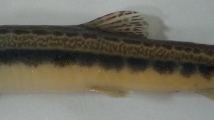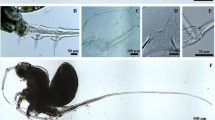Abstract
Several recent morphological studies of the genus Hirudo indicated that only Hirudo verbana is present in Serbia, while Hirudo medicinalis is completely absent. In order to test this hypothesis, specimens of medicinal leech from Serbia are analyzed for the first time by the method of DNA identification. The results show that individuals belonging to the species H. medicinalis are absent on the territory of Serbia, where only specimens of the sister (congener) species H. verbana can be found instead. All of the analyzed specimens can be related to five haplotypes. Two of the haplotypes are previously known from Ukraine, while three are newly discovered. It follows that genetic differentiation into eastern and western clades of the species H. verbana is unrealistic. Much more detailed sampling throughout the entire area is needed in order to establish the precise distribution of haplotypes. Factors posing a threat to both individual populations and the species as a whole are also considered as a basis for undertaking conservation measures for preservation of the species H. verbana. Such measures are necessary in view of the fact that for the past 8 years, H. verbana has been exported from Serbia to Western European countries instead of H. medicinalis (which does not live on the territory of Serbia). On the basis of the obtained results, the degree of threat to the species H. verbana is defined and preliminary protective measures are proposed for the conservation of this endangered species of aquatic invertebrate.




Similar content being viewed by others
References
Albrecht C, Wolff C, Glöer P, Wilke T (2008) Concurrent evolution of ancient sister lakes and sister species: the freshwater gastropod genus Radix in lakes Ohrid and Prespa. Hydrobiologia 615:157–167. doi:10.1007/s10750-008-9555-1
Baskova IP, Isakhanyan GS (2004) Hirudotherapy: science and practice. Monolit, Moscow (in Rusian)
Borda E, Oceguera-Figueroa A, Siddall ME (2008) On the classification, evolution and biogeography of terrestrial haemadipsoid leeches (Hirudinida: Arhynchobdellida: Hirudiniformes). Mol Phylogenet Evol 46:142–154. doi:10.1016/j.ympev.2007.09.006
Cites Trade Database (2014) http://trade.cites.org/. 14 Sept 2014
Clement M, Posada DCKA, Crandall KA (2000) TCS: a computer program to estimate gene genealogies. Mol Ecol 9:1657–1659. doi:10.1046/j.1365-294x.2000.01020.x
Elliott MJ, Kutschera U (2011) Medicinal leeches: historical use, ecology, genetics and conservation. Freshw Rev 4:21–41. doi:10.1608/FRJ-4.1.417
FinchTV Program (2014) http://www.geospiza.com. 15 Sept 2014
Folmer O, Black M, Hoeh W, Lutz R, Vrijenhoek R (1994) DNA primers for amplification of mitochondrial cytochrome c oxidase subunit I from diverse metazoan invertebrates. Mol Mar Biol Biotechnol 3:294–297
Hechtel FOP, Sawyer RT (2002) Toward a taxonomic revision of the medicinal leech Hirudo medicinalis Linnaeus, 1758 (Hirudinea: Hirudinidae): re-description of Hirudo troctina Johnston, 1816 from North Africa. J Nat Hist 36:1269–1289. doi:10.1080/00222930110048945
Kutschera U (2004) Species concepts: leeches versus bacteria. Lauterbornia 52:171–175
Kutschera U (2006) The infamous bloodsuckers from Lacus Verbanus. Lauterbornia 56:1–4
Kutschera U (2007a) Leeches underline the need for Linnaean taxonomy. Nature 447:775. doi:10.1038/447775b
Kutschera U (2007b) The taxonomic status of dark-pigmented medicinal leeches of the genus Hirudo (Hirudinea: Hirudinidae). Lauterbornia 59:1–6
Kutschera U (2012) The Hirudo medicinalis species complex. Naturwissenschaften 99:433–434. doi:10.1007/s00114-012-0906-4
Kutschera U, Elliott JM (2014) The European medicinal leech Hirudo medicinalis L.: morphology and occurrence of an endangered species. Zoosyst Evol 91:271–280. doi:10.3897/zse.90.8715
Kvist S, Oceguera-Figueroa A, Siddall ME, Erséus C (2010) Barcoding, types and the Hirudo files: using information content to critically evaluate the identity of DNA barcodes. Mitochondrial DNA 21:198–205. doi:10.3109/19401736.2010.529905
Marković Z (1998) Springs in mountainous regions of Serbia: ecological study of the macrozoobenthos. Dissertation, Faculty of Biology, University of Belgrade (in Serbian)
Markwardt F (2002) Hirudin as alternative anticoagulant-a historical review. Semin Thromb Hemost 28:405–414. doi:10.1055/s-2002-35292
Mesaroš G (2014) European Nature Legislation. In: Popović M, Radišić D, Rajkov S, Ružić M, Savić D, Šćiban M, Simović A (eds) Plant and animal species important for the protection of nature in European Union. Protego, Subotica, pp 1–104
Moquin-Tandon A (1846) Monographie de la famille des hirudinées. Ballière, Paris
Nesemann H, Neubert E (1999) Annelida, Clitellata: Branchiobdellida, Acanthobdellea, Hirudinea. In: Schwoerbel J, P Zwick (eds) Süßwasserfauna von Mitteleuropa, 6/2. Spektrum Akademischer Verlag, Heidelberg, pp 1–178
Official Gazette of the Republic of Serbia, No. 23/14 (2014) Order on prohibiting the collection of certain protected species of wild flora and fauna in 2014 (in Serbian)
Official Gazette of the Republic of Serbia, No. 24/12 (2012) Order on prohibiting the collection of certain protected species of wild flora and fauna in 2012 (in Serbian)
Official Gazette of the Republic of Serbia, No. 47/11 (2011) Book of regulations on the proclamation and protection of strictly protected and protected wild species of plants, animals, and fungi (in Serbian)
Official Gazette of the Republic of Serbia, No. 5/10 (2010) Book of regulations on the proclamation and protection of strictly protected and protected wild species of plants, animals, and fungi (in Serbian)
Official Gazette of the Republic of Serbia, No. 69/11 (2011) Decree on alteration of the edict on establishment of control over utilization and traffic of the wild flora and fauna (in Serbian)
Oikonomou A, Leprieur F, Leonardos DI (2014) Biogeography of freshwater fishes of the Balkan Peninsula. Hydrobiologia 738:205–220. doi:10.1007/s10750-014-1930-5
Petrauskiené L (2008) The use of the medicinal leech (Hirudo sp.) in ecotoxicological and other scientific research—a short review. Lauterbornia 65:163–175
Sawyer RT (1986) Leech biology and behaviour: anatomy, physiology and behavior, vol 1. Oxford University Press, New York
Siddall ME, Trontelj P, Utevsky SY, Nkamany M, Macdonald KS (2007) Diverse molecular data demonstrate that commercially available medicinal leeches are not Hirudo medicinalis. Proc R Soc B 274:1481–1487. doi:10.1098/rspb.2007.0248
Simić V, Simić S, Paunović M, Cakić P (2007) Model of the assessment of the critical risk of extinction and the priorities of protection of endangered aquatic species at the national level. Biodivers Conserv 16:2471–2493. doi:10.1007/s10531-006-9130-x
Sket B, Trontelj P (2008) Global diversity of leeches (Hirudinea) in freshwater. In: Balian EV, Lévêque C, Segers H, Martens K (eds) Freshwater animal diversity assessment. Springer, Netherlands, pp 627–637
Skoulikidis N, Economou AN, Gritzalis K, Zogaris S (2009) Rivers of the Balkans. In: Tockner K, Uehlinger U, Robinson CCT (eds) Rivers of Europe. Academic Press, Elsevier, Amsterdam, pp 421–466
Sohn JH, Kang HA, Rao KJ, Kim CH, Choi ES, Chung BH, Rhee SK (2001) Current status of the anticoagulant hirudin: its biotechnological production and clinical practice. Appl Microbiol Biotechnol 57:606–613. doi:10.1007/s00253-001-0856-9
Tamura K, Peterson D, Peterson N, Stecher G, Nei M, Kumar S (2011) MEGA5: molecular evolutionary genetics analysis using maximum likelihood, evolutionary distance, and maximum parsimony methods. Mol Biol Evol 28:2731–2739. doi:10.1093/molbev/msr121
Trontelj P, Utevsky SY (2005) Celebrity with a neglected taxonomy: molecular systematics of the medicinal leech (genus Hirudo). Mol Phylogenet Evol 34:616–624. doi:10.1016/j.ympev.2004.10.012
Trontelj P, Utevsky SY (2012) Phylogeny and phylogeography of medicinal leeches (genus Hirudo): fast dispersal and shallow genetic structure. Mol Phylogenet Evol 63:475–485. doi:10.1016/j.ympev.2012.01.022
Utevsky SY, Zinenko AI, Atemasov AA, Huseynov MA, Utevska OM, Utevsky AY (2008) New information on the distribution of the medicinal leech (genus Hirudo) in the Iberian Peninsula, the Caucasus and Central Asia. Lauterbornia 65:119–130
Utevsky SY, Zagmajster M, Atemasov A, Zinenko O, Utevska O, Utevsky A, Trontelj P (2010) Distribution and status of medicinal leeches (genus Hirudo) in the Western Palaearctic: anthropogenic, ecological, or historical effects? Aquat Conserv 20:198–210. doi:10.1002/aqc.1071
Vanhove MPM, Economou AN, Larmuseau MHD, Zogaris S, Giakoumi S, Kalogianni E, Volckaert FAM, Huyse T (2012) Phylogenetics and biogeography of the Balkan ‘sand gobies’ (Teleostei: Gobiidae): vulnerable species in need of taxonomic revision. Biol J Linn Soc 105:73–91. doi:10.1111/j.1095-8312.2011.01781.x
Westendorff M, Kalettka T, Jueg U (2008) Occurrence of leeches (Hirudinea) in different types of water bodies in northeast Germany (Brandenburg). Lauterbornia 65:153–162
Zapkuviené D, Petrauskiené L (2000) Medicininé délé: anatomija, fiziologija, ekologija. Ekologijos institutas, Vilnius
Živić I (2005) Faunistical and ecological study of macrozoobethos in the rivers of the Južna Morava basin with an emphasis on taxonomy of Trichoptera larvae (Insecta). Dissertation, Faculty of Biology, University of Belgrade (in Serbian)
Acknowledgments
The present study was supported by the Serbian Ministry of Education, Science and Technological Development (Project No. TR 31075 and III 43001).
Author information
Authors and Affiliations
Corresponding author
Additional information
Handling Editor: Piet Spaak.
Rights and permissions
About this article
Cite this article
Živić, I., Radosavljević, T., Stojanović, K. et al. The first molecular characterization of the genus Hirudo on the territory of Serbia: estimation of endangerment. Aquat Ecol 49, 81–90 (2015). https://doi.org/10.1007/s10452-015-9506-7
Received:
Accepted:
Published:
Issue Date:
DOI: https://doi.org/10.1007/s10452-015-9506-7




